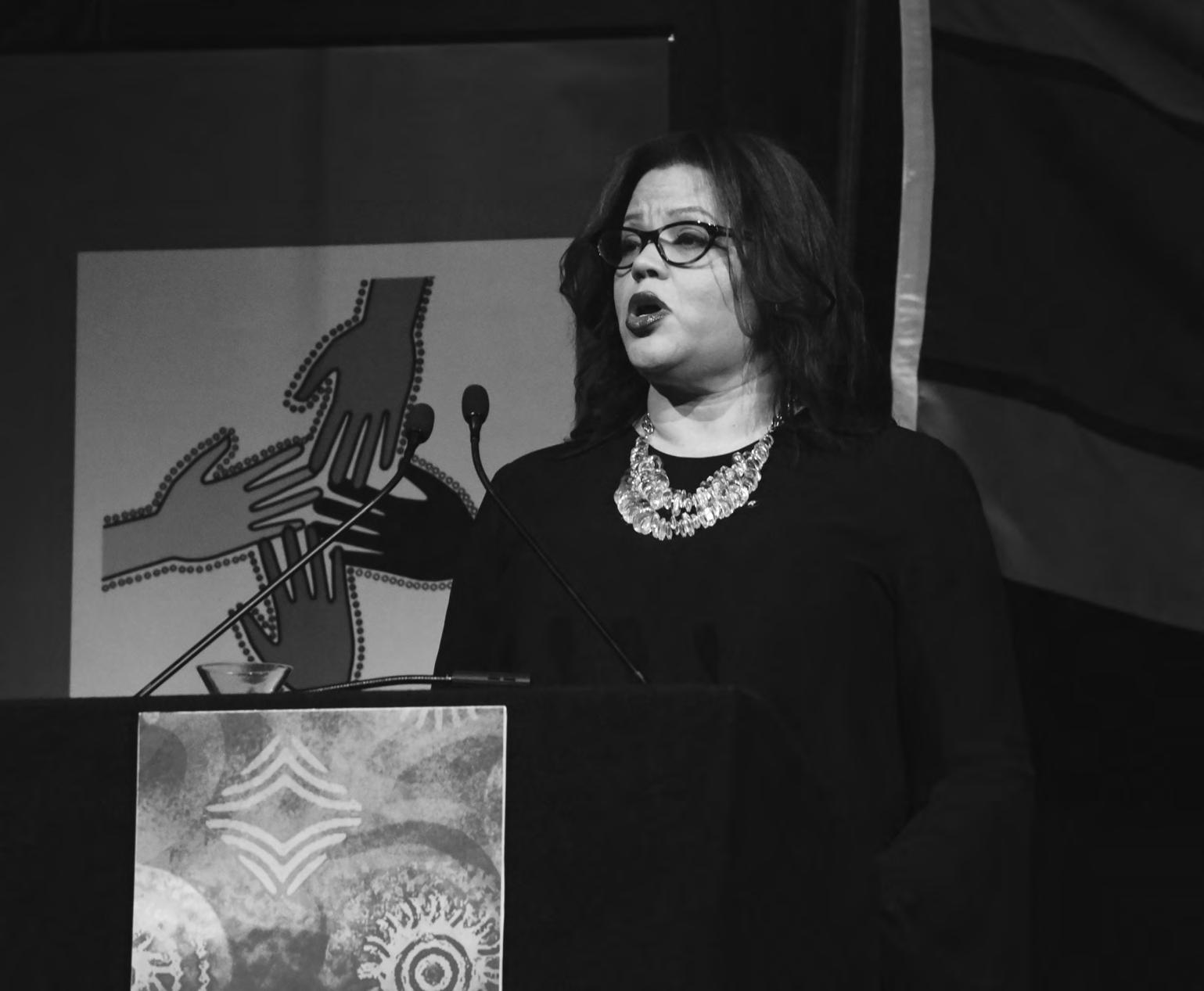
22 minute read
Recognition or Treaty – is there an either/or choice?
The national Recognise Movement, established to pursue constitutional recognition of Aboriginal and Torres Strait Islander people, says that treaty and constitutional change can co-exist.
Co-convenor of the national Recognise Movement at the time, Ms Tanya Hosch, told a gathering of around 1500 people at the National Reconciliation Week Breakfast in Adelaide that “we can walk and chew gum at the same time”.
Advertisement
“For me and so many other Aboriginal and Torres Strait Islander peoples who support treaty and constitutional recognition, we know that this is not an either/or choice. “I strongly reject the false choice that is promoted by some when it comes to constitutional recognition and treaty,” she said. “We should not be asked to choose.”
As an example, she referred to talks about a possible state based treaty that had taken place in Victoria recently. “If we had our referendum last week and achieved recognition would it have prevented that? Of course not.” The speech followed increasing calls for treaty in place of constitutional recognition. Alice Haines is a Gommeroi woman from the ‘We Oppose Recognition’ campaign. She recently told Radio Adelaide Breakfast that she has many concerns about the Recognise campaign, but one is that it is promoting a ‘Yes’ vote without a specific model available to be considered.
“They’ve been promoting the constitutional reform for the last five years,” she said “they’ve injected millions and millions of dollars into this, wasting taxpayers money actually, and they’ve not even allowed a ‘No’ campaign which is normally the procedure for any referendum in Australia,” she said. When asked if Australia can have constitutional recognition and a treaty side by side, Ms Haines said: “Well you don’t need constitutional recognition if you have a treaty, because it will fix the blunders that the Australian government’s ones have got.” “A treaty is an agreement between foreign nations, and if we are integrated into the Australian Constitution, we’ve merged, we’re not foreign anymore. So we’re part of DFAT, Department of Foreign Affairs and we will not necessarily be part of that anymore, we will be integrated so, you can’t treaty within yourself,” she said. In an article for The Griffith Review, Professor Megan Davis has offered an analysis of the government’s handling of the Recognise campaign and reasons behind some Indigenous people’s resistance to it.
“The recognition process, in and of itself, has been long and drawn out,” she wrote. “Add to the mix, for the first time in Australia’s disastrous referendum history, a public relations campaign to lobby for a ‘Yes’ vote, despite there being no reform to vote for. It was predictable that the campaign would attract the ire of an impecunious Aboriginal sector, gutted by ruthless funding cuts. “This was contemporaneous with the government’s marquee policy, the Indigenous Advancement Strategy, which had the brutal impact of laying people off, while organisations lost frontline services, programs and policies. “The campaign has galvanised a resistance movement. Still, political leaders, commentators and policymakers seem blithely unaware. On a fundamental level they need to acknowledge that a model is a necessary prerequisite to Indigenous people forming a reasonable opinion on the matter,” Professor Davis wrote.
In her speech for National Reconciliation Week, Ms Hosch acknowledged that the Recognise campaign is in a difficult stage. However she called on supporters to continue their efforts.
“Of course I would like to be standing before you today and saying the model’s agreed and ready and the referendum is imminent and everything is perfect,” she said.
“But as we know, it’s not that simple.” “The truth is this is really hard work and we are in the toughest period of this campaign and it will get tougher.” “But if we can be tough, then I predict when we look back at this time, we will see it as an era where we significantly moved the dial on political aspirations for Aboriginal and Torres Strait Islander peoples,” Ms Hosch said. She also told the audience at the Reconciliation Week breakfast that the concept of constitutional recognition had strong support, with 77% of nonindigenous and 87% of Indigenous Australians saying they would vote yes in a referendum if it were held that day. Indigenous academic Marcia Langton also says that the treaty or recognition debate is not a matter of choosing one or the other option. She is an editor of a new collection of essays by Indigenous people “Indigenous Arguments for Constitutional Recognition”. In the book, Indigenous commentators including Patrick Dodson, Noel Pearson, Dawn Casey, Nyunggai Warren Mundine and Mick Mansell, set out a wide range of ideas for ways of achieving recognition. Professor Langton says there is a range of political views held by the Indigenous people who contributed to the book but they have important things in common. “We share this history and know that there’s unfinished business” she said.
“How we resolve it we may differ on, but all of us agree that whatever happens must be meaningful to Indigenous people, it can’t be window dressing. We can’t agree to the race to the bottom for a minimalist proposition that might make non-Indigenous Australia look good in the world, but not actually address the way we’ve been excluded from the polity since Federation.”
What is Constitutional Recognition?
The Referendum Council says that the elements of referendum changes could include:
• Addressing the sections of the Constitution, including section 25 and section 51 (xxvi) that are based on the outdated notion of ‘race’.
• Ensuring continued capacity for the Commonwealth Government to make laws for Aboriginal and Torres Strait Islander peoples. • Formally acknowledging Aboriginal and Torres Strait Islander peoples as the First Peoples of Australia. • Providing an Aboriginal and Torres Strait Islander body to advise Parliament about matters affecting Indigenous peoples. • Providing a constitutional prohibition on racial discrimination.
What is Treaty?
A treaty is a binding agreement between two or more states or sovereign powers. Treaties outline the points of agreement between the parties. A treaty is similar to a contract in that the parties to a treaty usually agree to take on certain responsibilities and duties which are legally binding. While the word treaty usually brings to mind treaties under International law, many European countries signed treaties with the Indigenous peoples of the lands they colonised. New Zealand has one national treaty. Canada has nearly 100 treaties signed with First Nations people. These treaties are recognised in constitutional amendments. The United States signed many treaties with Native Americans tribes in the 1700s, but these were often used to force Native Americans off their land and the agreements were broken. Tribal sovereignty is recognized in the US constitution and allows for the Native American peoples to engage with the Federal Government on a ‘nation to nation’ level.
Source: NITV http://www.sbs.com.au/nitv/explainer/explainer-what-treaty
Asked if treaty and constitutional recognition can exist together, Professor Langton said “Constitutional change and treaty making, agreement making are not mutually exclusive. “I think many people don’t understand how treaty encompasses many different types of agreements. We have a very strong agreement making culture in Australia, particularly because of the Native Title Act provisions that provide for Indigenous Land Use Agreements and other agreements for land access. And some of our agreements are as much like treaties in Canada and elsewhere in North America as you could possibly get. “Constitutional change does not exclude treaty making. In fact, if you’re intelligent about it, the idea that there could be agreements with First Nations Peoples is a much stronger proposition than if you have Indigenous peoples recognised in our constitution as first Australians,” Professor Langton said. The Referendum Council, a group of prominent Australians tasked by the Prime Minister and Opposition Leader to find the best way forward on constitutional recognition, has announced a new round of community discussions over the last half of 2016.
Above: Tanya Hosch at Reconciliation Breakfast.
The process starts with three meetings with Aboriginal and Torres Strait Islander leaders, including traditional owners and representatives of peak bodies. It’s expected that that will gather a general consensus on how to proceed. The Council will then hold consultations with the general community and Indigenous people. The consultations will include discussions in each state for Aboriginal and Torres Strait Islander peoples to discuss options for a referendum proposal that could be supported by Indigenous peoples. The general population can participate in the discussion in a new national online forum.
All of the conversations will lead to a convention on constitutional recognition at Uluru by year’s end.
Further information:
For more information on the Referendum Council’s upcoming community meetings:
https://www.dpmc.gov.au/ indigenous-affairs/constitutionalrecognition
Aboriginal Regional Authorities Policy for closer governance
After extensive consultation with Aboriginal communities and groups since 2013, the State Government has formalised the Aboriginal Regional Authority (ARA) Policy.
The purpose of the policy is to forge a closer working relationship between Aboriginal governing structures in remote locations and the State Government.
The Far West Coast Aboriginal Corporation, Adnyamathanha Traditional Lands Association, and the Ngarrindjeri Regional Authority will be the first Aboriginal Regional Authorities to form partnership with the government under this policy. The Far West Coast Aboriginal Corporation represents the Wirangu, Mirning, Kokatha, Maralinga Tjarutja, and Yalata people, as well as the descendants of Edward Roberts. The Corporation is the only fully Aboriginal-owned and managed support, advocacy, and supplementary funding body for Far West Coast Aboriginal people.
The Adnyamathanha Traditional Lands Association represents the Adnyamathanha communities of the Flinders Ranges. The Association includes more than 20 different language groups, and is involved in economic development opportunities (including purchasing the Wilpena Pound Resort) to enhance the wealth and financial autonomy of the Adnyamathanha people.
The Ngarrindjeri Regional Authority represents the Ngarrindjeri people of the Lower River Murray and Coorong region. The Authority has been a pioneer of Aboriginal nation-building in South Australia, and in 2009 entered into a landmark agreement with the government which made Ngarrindjeri involvement central in critical water and land management programs along the Lower Murray and Coorong. Ms Nerida Saunders, Executive Director Of Aboriginal Affairs and Reconciliation Division of the Department of State Development joined Kaliah on Aboriginal Message to discuss the new policy and its purpose. She said it is “about working more collaboratively with Aboriginal communities”. Aboriginal Affairs and Reconciliation Minister Kyam Maher said the new policy marked a major shift in the way Aboriginal South Australians and governments do business together.
“The policy will enable Aboriginal communities to register as an Aboriginal Regional Authority, and therefore connect more directly with other Aboriginal communities and the State Government,” he said.
“ARAs will bring together Aboriginal nations and communities to better represent their people and drive regional priorities and economic growth, as well as giving government more clarity when working with communities on issues impacting on Aboriginal South Australians,” he said.
For more information visit
statedevelopment.sa.gov.au
Ceduna residents who receive government income support are currently trialling the controversial cashless welfare card.
The card is designed to reduce the amount of cash available to welfare recipients and act as a standard debit card with restrictions on purchases of alcohol or gambling. Last year, the Department of Social Services (DSS) announced the trial of the Cashless Welfare card for Ceduna.
Following extensive negotiation with members of the community including Aboriginal leaders, the 12-month trial launched in March this year. The trial has received a mixed response from residents.
Sue Coleman-Haseldine, a Kokatha Elder said early on in the trial that “the general feeling is depression, they [residents] are no longer in charge of their affairs. “There are people who take money from their account to put on their credit card to pay their bills, now they cannot do that. People paying rent, house payments or car payments, are going to fall behind because the card is not set up properly yet,” she said. The application of the card did not come without issues said Geoffrey Moffatt, CEO of the District Council of Ceduna. “The terminal in the post office wouldn’t allow people to pay their water, electricity and phone bills, due to a technical glitch for a month. We took it to the federal DSS – who tried to help in every way that they could. That’s all been fixed now,’ he said.
Mr Moffatt said that shops in Ceduna had increased the availability of EFTPOS machines to make using the cards easier. Mick Haynes, Ceduna Aboriginal Corporation chief executive told the ABC that he was in support of the trial because better money management was needed in the community. “For far too long, members of our community have been dying… There’s alcohol-fuelled violence, domestic violence and people have been misusing their money. The community discussed all these issues and thought we needed to change things for the better,” he said. Senator Rachel Siewert, community services spokesperson for The Greens, raised the concern that there could be additional merchant fees for those who used EFTPOS at a location that had a minimum spending balance. “When you’re on income support, every dollar counts. So that’s an extra cost that somebody on income support is going to have to bear,” Ms Siewert said to the ABC. The trial will continue until early next year, after which a review will be held.
Changes to the Indigenous Advancement Strategy – where to from here?
Since the launch of the Government’s Indigenous Advancement Strategy in 2014, application for funding has proven problematic for Aboriginal organisations, especially small organisations and at a grassroots level.
Late last year, a review of the program was made with feedback from over 100 submissions to parliament and 500 people attending public forums. Point Pearce community gave a submission stating that the funding application was difficult and unreasonable. The community’s submission stated how many people found the former guidelines to be too challenging. “The information that was sought was conflicting in its desire and this was the case for many others who we have spoken to – they also found it very difficult to keep within those very stringent guidelines.” The submission stated the community felt the application to be most daunting for even the best of application writers – “that is if they could afford one”. South Australian Native Title Services supports the view that the IAS is flawed saying it favours large mainstream organisations over Aboriginal organisations and is too broad to understand its main funding concerns. SANTS’ submission said the “broadness of program has benefits in terms of providing opportunities for holistic approaches, but also lose a degree of focus that targeted rounds provide. The broadness also favours larger organisations which have the resources and expertise at hand to pull together an application/project with multiple components/partners and outcomes. “The broadness of the program did not reflect the clear priorities of the government.” Keith Thomas, South Australian Native Title Services CEO said “this was not a welcome change to Indigenous funding as it shows a severe lack of engagement with community and no care or vision for what Aboriginal and Torres strait Islander people need. Furthermore, the IAS limits native title potential by excluding funding for land activities by native title service providers,” he said. The National Aboriginal Congress stated how the “limited six-week application timeframe and delayed funding announcements has caused undue confusion, stress and difficulty to Aboriginal and Torres Strait Islander organisations. The overall lack of foresight in planning adequate application, submission and processing timeframes, disadvantaged Aboriginal and Torres Strait Islander organisations in various ways”. As at March 2016 new guidelines were implemented based on the submissions and suggestions made by the public. The new guidelines allow organisations to apply for grants at any time. Applicants can now submit more than one application when proposing activities that are not closely related, and clearer application process is now in place.
The new guidelines relate to grants and not goods and services funded under the IAS. The same three targeted areas of the IAS funding is as before: Jobs, Land and economy children and Schooling safety and wellbeing culture and capability, remote Australia Strategies. Mr Thomas said that more information is needed for community to understand the changes and the funding process, in general.
“This is all well and good that these changes have been implemented but we have heard nothing from government about the new funding guidelines and it makes me wonder why. I look forward to seeing how these changes assist community to achieve their business objectives and receive proper funding for important projects going forward”.
Financial Management Training for PBCs
In May, South Australian Native Title Services and PwC’s Indigenous Consulting conducted a financial management training workshop for native title body corporates (PBCs).
The training aimed to build the capability of PBC Directors to actively and effectively manage the financial affairs of their corporations. Participants learnt about financial responsibilities, establishing sound financial management systems, reading and interpreting financial reports, investments strategies and financial decision making. Sally Clark, PwC’s Indigenous Consulting Manager said there was positive feedback from participants for the first training course of its kind. “Both groups engaged extremely well during the training. I felt that they benefited greatly even though this was only an overview of Financial Management for PBCs. “This was a pilot training course and the feedback was very positive and we will be tweaking the content based on the feedback provided to make it more hands on next time,” she said. Keith Thomas, South Australian Native Title Services CEO said he was pleased with the outcome of the training and looks forward to future workshops. “The native title representatives who attended the workshop gained some valuable skills in the areas of financial management. The training included key activities such as financial reporting, business planning and risk management. These are all essential skills to have when running a business. “The collaboration between PwC and SANTS was successful and I hope that we can continue to work together to provide PBCs with future learning opportunities,” he said. Ms Clark said “I encourage PBCs who feel they need to build their knowledge of financial management to register their interest with SANTS”.
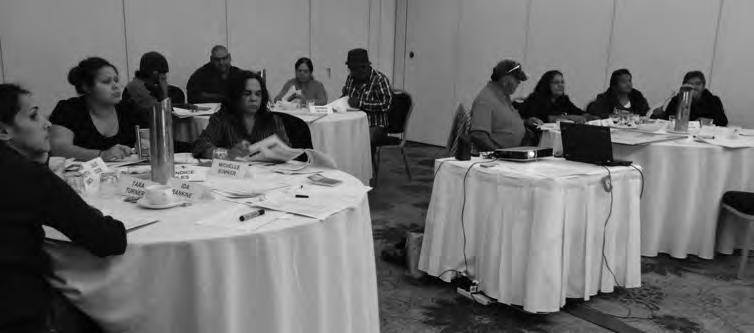
For more information or to register for the next workshop contact Tom Jenkin at South Australian Native Title Services on (08) 8110 2800 or tomj@nativetitlesa.org
“Songlines: the living narrative of our nation” was the theme of NAIDOC Week 2016.
Joyleen Thomas, Chairperson of the NAIDOC SA Committee, spoke of songlines in her opening address at Adelaide Town Hall for the annual NAIDOC flag raising ceremony. “It is a vehicle that is used for handing down our culture, our traditions, our laws and our customs and that define us as a people connected to land, sea and sky. “As the first peoples of this ancient land we understand the deep significance of songlines, our stories. “Songlines are broadly described as creation stories that criss-cross Australia and trace the journeys of our ancestral spirits who sang that land to life. “For example, my uncle is an Arabana elder and he always tells his grandchildren the story about the creation of a lake in his country – known as Lake Carra Barra Wirra Canna. That lake was created by the seven sisters, one of our most significant stories. The Arabana word actually describes it as ‘Lake That The Stars Danced Upon’. And it is a magical place, I imagine them dancing there and spreading star-dust in that area,” she said. “The storyline of the seven sisters is a big story. It runs the length and breadth of this country. It is a bit like reading the Christian Bible. There is a big book that tells that story, a creation story. And for each nation, we have a chapter in that book. Not only do we have chapters, we have layers. “So there might be a story about the stars dancing upon the lake that we are telling the children, but there is another story that adds depth, that talks about what women only know. There might be another story that talks about what men only know. So I’m not talking about a simple story. I’m talking about a very complex story. So not only is it broad in that it is a long story, it covers a long way. It has depths and layers. “So in that place, that particular story tells us that all men should be respecting women. And I think that it is an apt story, with the focus these days on us stopping violence against women and making sure women are nurtured, thought about and cared for. That part of that chapter is based in Port Augusta and there is a site there that teaches us to be respectful and to care for women,” said Ms Thomas.
After the ceremony, the NAIDOC Week award winners were announced, with 11 recipients this year. John Chester was named ‘Person of the Year’, for his work with the Aboriginal Lands Trust.
Ms Thomas said “he championed the communities in good land management practices, a topic that is close to his heart.”
Mr Chester said he was humbled and overwhelmed by the award, “a lot of work that has been achieved on the lands over the years and it’s good to be recognised for the achievements that have happened.
“I first started in 1994 as the Range Lands Officer, as funded by the Primary Industries and Resources. It was due to the lands being in very poor condition and there being no support for Aboriginal communities.
“Canberra approached the Aboriginal Lands Trust, the CEO Chris Larkins, to try and extend the program. We were having so much success in South Australia in dealing with land management and land care and heritage issues, that I was asked to be involved with the development of an indigenous land management facilitation network for the rest of the nation, based on what the Lands Trust was achieving here,” Mr Chester said.
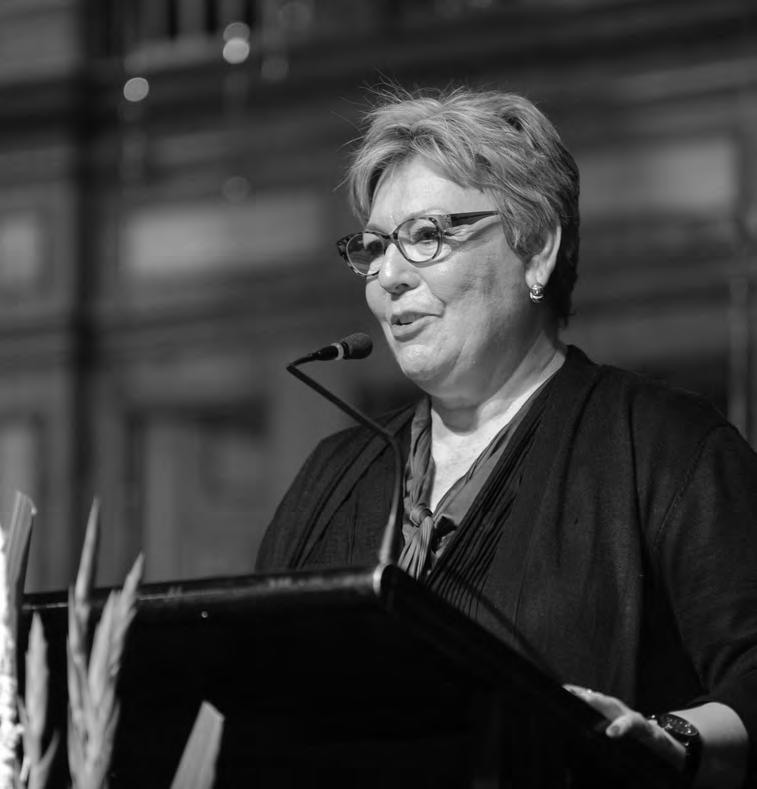
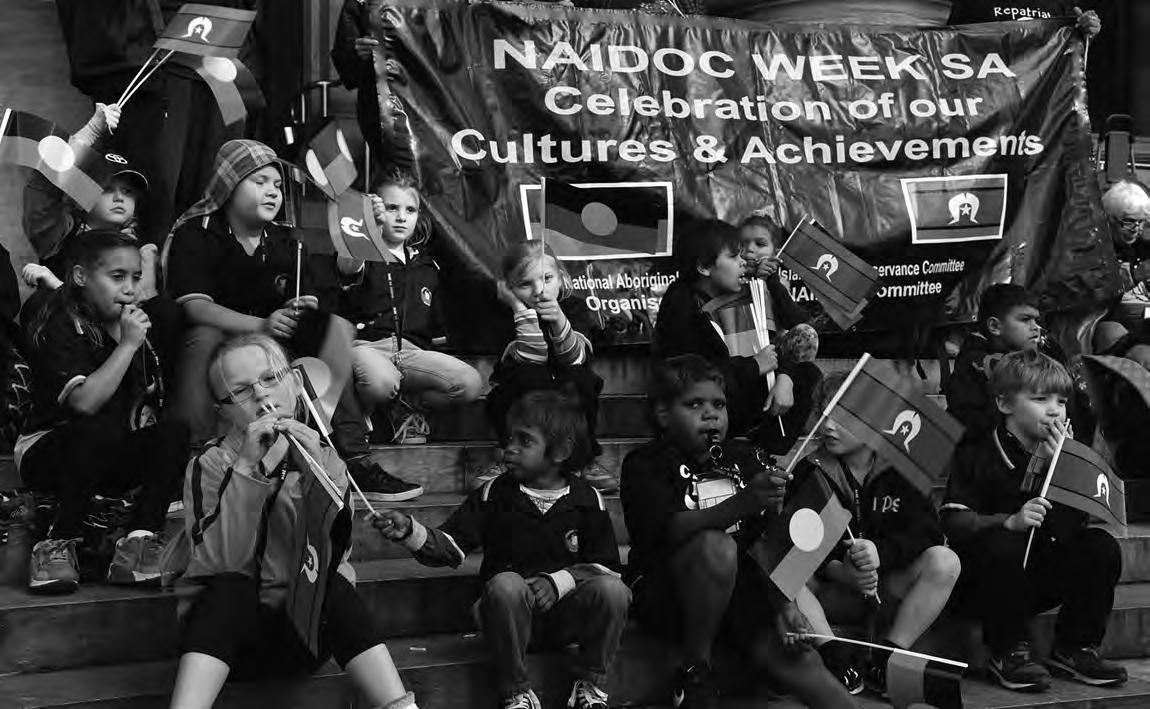
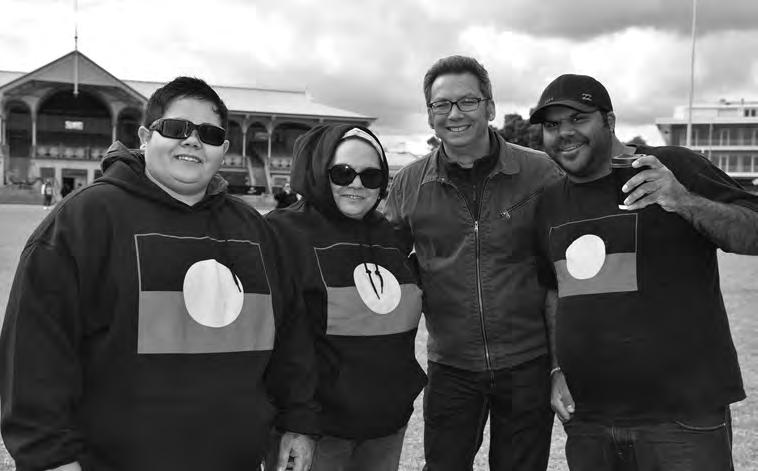
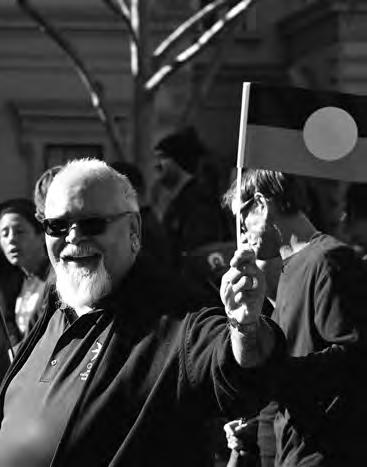
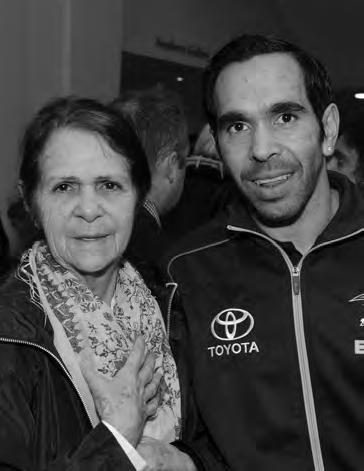
‘Scholar of the Year’ went to Ngarrindjeri Kaurna woman, Tanya Guerrera, for her academic achievements. She works predominantly with youths and their families, addressing the impacts of incarceration as an Aboriginal Mental Health Consultant with Child and Adolescent Mental Health Service (CAMHS).
Ms Guerrera’s most recent achievement was graduating from a degree in Social Work at Deakin University. This was despite many challenges along the way including juggling a full-time job, studying away from home and dealing with the loss of her father.
After receiving the award, Tanya reported feeling quite overwhelmed and emotional, “usually I’m the one nominating. But I’m grateful, very grateful. “I wasn’t a school person at all. I wagged more school than I attended – the honest truth. It wasn’t until I was a woman with my own family that I actually realised that I did need some education, and went back to Tauondi College when it was down at Largs Bay North and did a 12 month bridging course there. “Later on, I enrolled in uni and started to do some study in Aboriginal Cultures. I stopped because I had some deaths in the family, but I took it up again. I pulled out again because of another death in the family - I found it really hard to cope. But this time round, two and a half years ago, I started again and my dad said “just go Tanya, just keep doing it, just keep doing it.” Dad was pretty sick at the time, and nearing the end I lost him while studying, but it was his voice in the background It was a record turnout for the annual NAIDOC march from Victoria Square/ Tarntanyangga down King William Street to Parliament House with over one thousand attendees, organisers said. Jeffrey Newchurch and Stephen Goldsmith welcomed everyone to Kaurna Country and started the march with the suggested call “songlines – the story of our nation – songlines, deadly aye”. King William Street was awash with Aboriginal and Torres Strait Islanders flags and colours as the group made its way to the steps for speeches from Dwayne Coulthard, Khatija Thomas and Tauto Sansbury. Mr Coulthard raised the crowd by reminding them how important songlines and NAIDOC week are for the children and future generations. “Let’s invest in our youngfellas today and keep our songlines alive!” he said. Ms Thomas spoke about how important it was to pass knowledge and culture on, to keep it strong. The children and young people were invited to sit on the steps of Parliament house while the speeches were made. Afterwards, people were invited to catch the bus to Victoria Park for the Family Fun Day, where there were stalls from various groups and plenty of activities for the young and the young at heart.


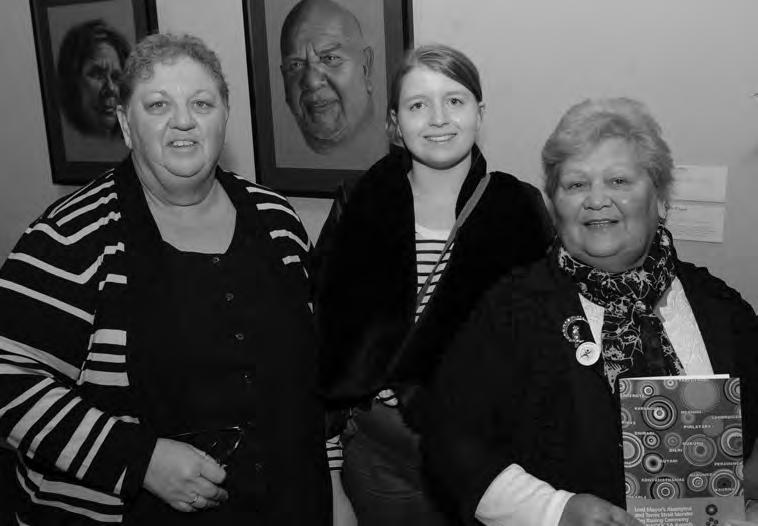


This page, clockwise from top: Shirley Peisley, Jullie Gollan and NAIDOC Awards guest; Frank Lampard, Yvonne Koolmatrie and Shirley Gollan; Frank Lampard and NAIDOC marcher; NAIDOC celebrations; Suzanne Hewson, NAIDOC Awards guest and Eunice Marsh.
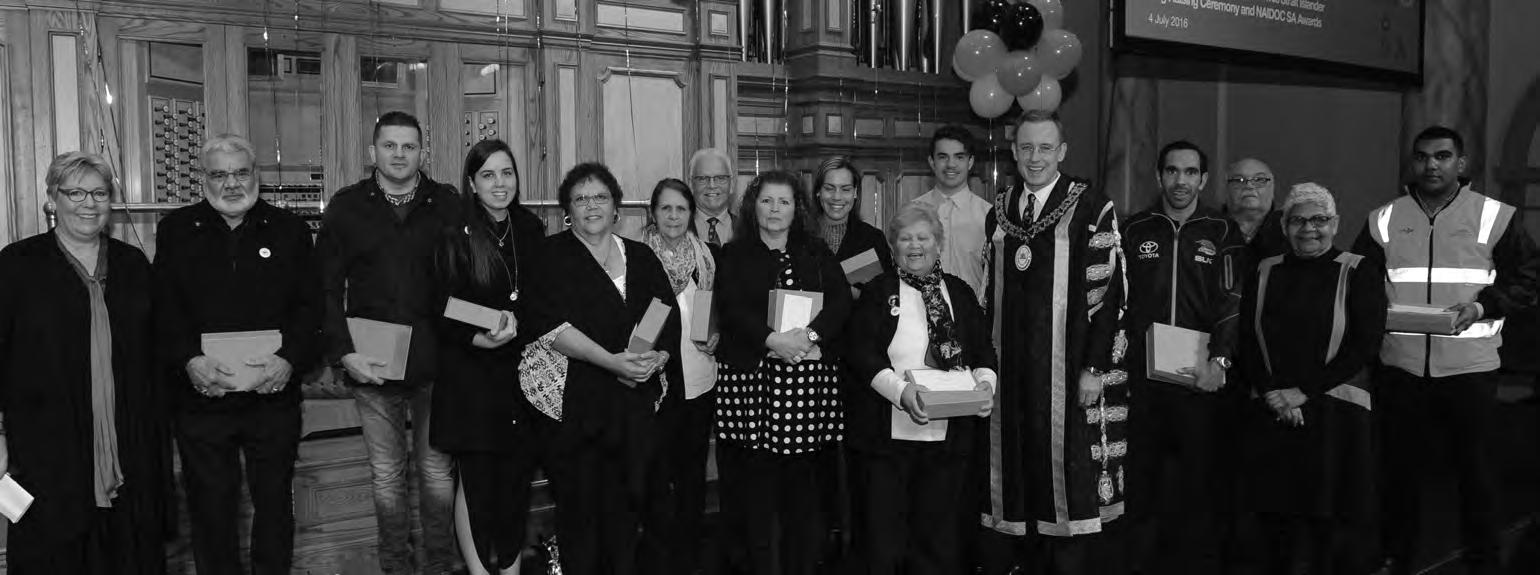
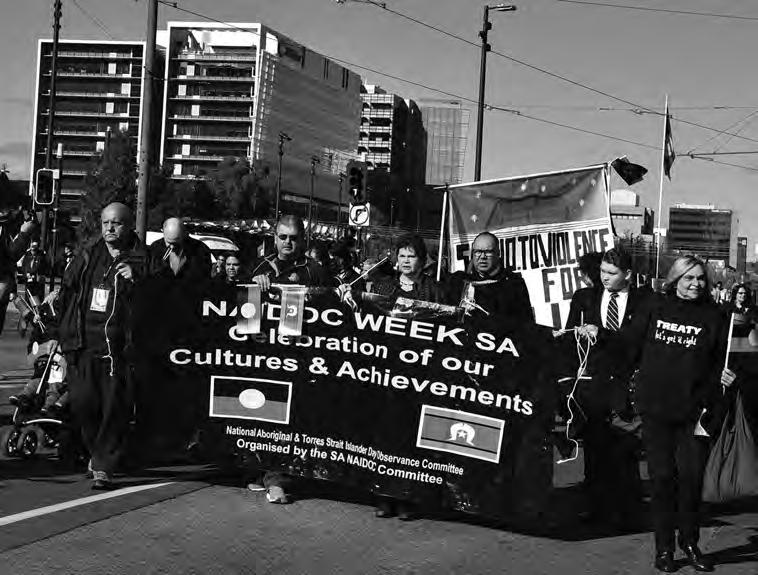
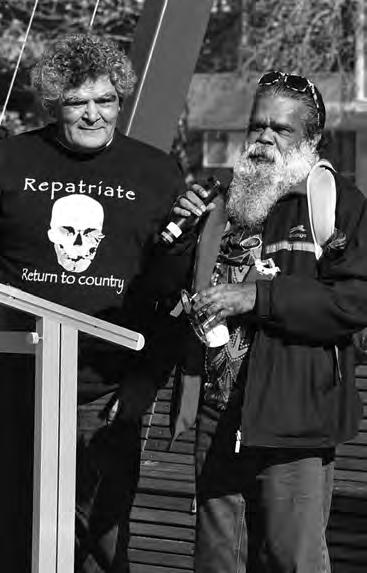

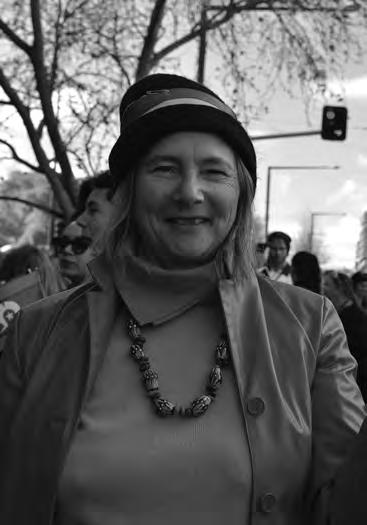
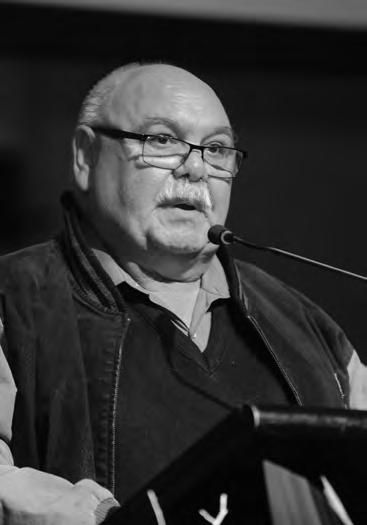
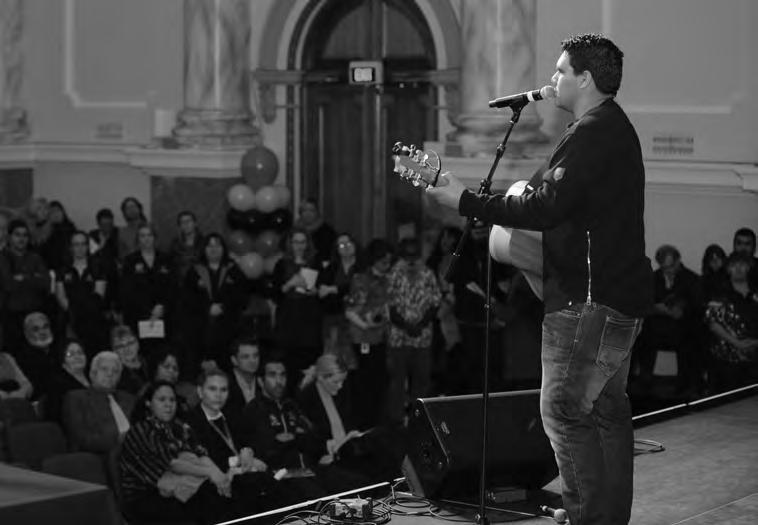
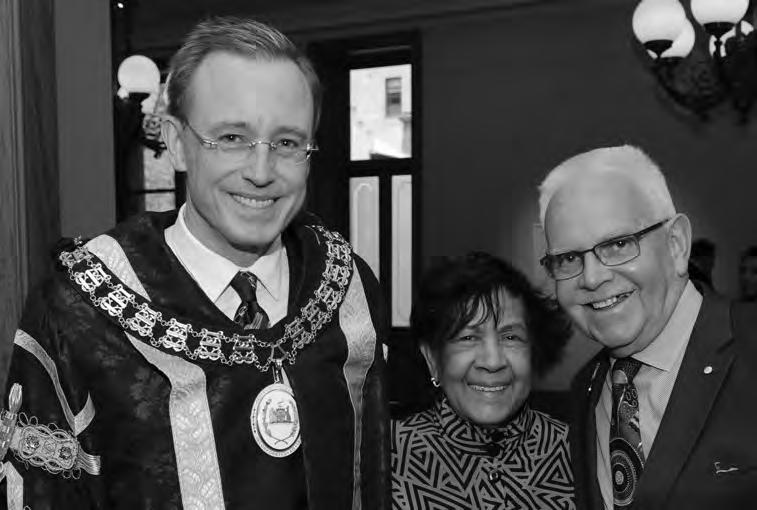
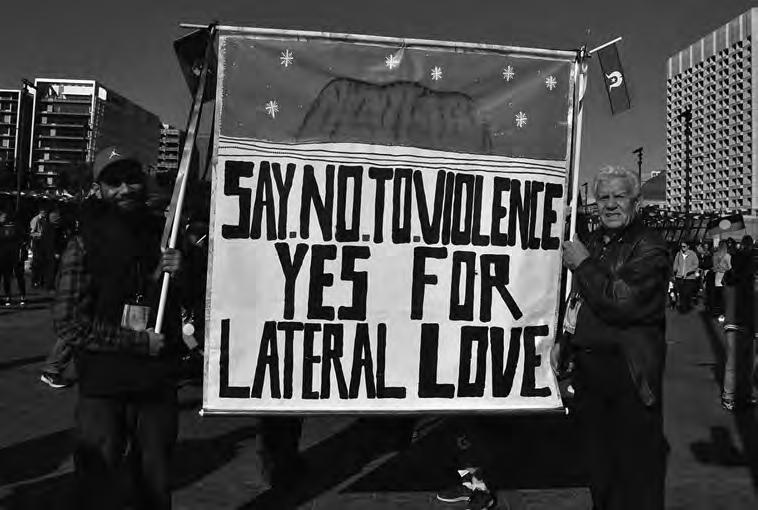
This page, left to right: Top row: Lord Mayor Martin Haese with all 2016 NAIDOC SA Award Winners. Second Row: NAIDOC 2016 SA March; Jeffrey Newchurch and Stephen Gadlabarti Goldsmith; Joyleen Thomas. Third row: NAIDOC Marcher; John Chester; Nathan May at NAIDOC Awards. Fourth row: Martin Haese, Yvonne Agius and Frank Lampard; NAIDOC March.




